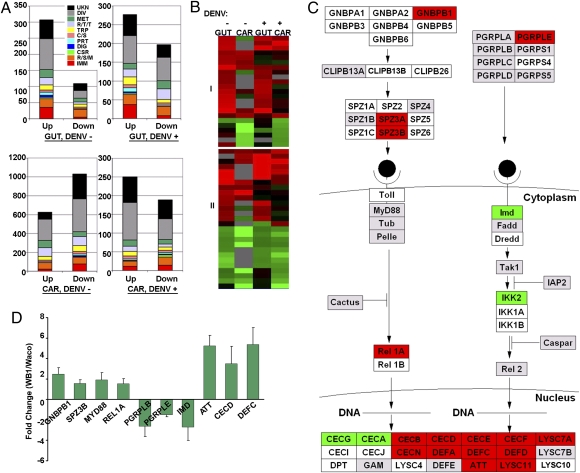Fig. 1.
Wolbachia-regulated genes in Ae. aegypti. (A) Functional classification of differentially expressed genes in the midgut (GUT) and carcass (CAR) of 7-d-old mosquitoes before a blood meal (DENV−) and 12 d after infection with DENV serotype 2 (DENV+). The graph shows the functional class distributions in real numbers of genes that are regulated by Wolbachia (“Up” indicates induced, and “Down” indicates repressed). The Wolbachia-regulated gene expression data are presented in Tables S1, S2, S3, and S4. Functional group abbreviations: C/S, cytoskeletal and structural; CSR, chemosensory reception; DIG, blood and sugar food digestive; DIV, diverse functions; IMM, immunity; MET, metabolism; PRT, proteolysis; R/S/M, redox, stress, and mitochondrion; R/T/T, replication, transcription, and translation; TRP, transport; UNK, unknown functions. (B) Cluster analysis of 23 immune genes (I) and 27 R/S/M genes (II) that were regulated in midguts and carcasses of Wolbachia-infected female mosquitoes in at least two of four combinations: midgut with (GUT+) or without (GUT−) DENV infection; carcass with (CAR+) or without (CAR−) DENV infection. All genes presented in the cluster are listed in Tables S5 and S6. (C) Regulation of putative Toll signaling pathway genes by Wolbachia in the mosquito midgut 12 d after feeding on DENV-infected blood. Red, green, and gray colors indicate Wolbachia-responsive up-, down- and nonregulated genes, respectively. White indicates unfound or filtered signal. The pathway was built with GenMAPP software based on the immunogenomics prediction (49, 50). CECB, Cecropin B; CECE, Cecropin E; CECF, Cecropin F; CECG, Cecropin G; CECI, Cecropin I; CECJ, Cecropin J; CECN, Cecropin N; CLIPB13A, Clip-domain serine protease 13A; CLIPB13B, Clip-domain serine protease 13B; CLIPB26, Clip-domain serine protease 26; DEFD, Defensin D; DEFE, Defensin E; DPT, Diptericin; Dredd, Death-related ced-3/Nedd2-like protein; Fadd, Fas-Associated Death Domain; GAM, Gambicin; GNBPA1, Gram-negative binding protein A1; GNBPA2, Gram-negative binding protein A2; GNBPB3, Gram-negative binding protein B3; GNBPB4, Gram-negative binding protein B4; GNBPB5, Gram-negative binding protein B5; GNBPB6, Gram-negative binding protein B6; IAP2, Inhibitor of apoptosis 2; IKK1A, I-Kappa-B Kinase 1 A; IKK1B, I-Kappa-B Kinase 1 B; IKK2, I-Kappa-B Kinase 2; LYSC4, C-Type lysozyme 4; LYSC7A, C-Type Lysozyme 7A; LYSC7B, C-Type Lysozyme 7B; LYSC10, C-Type lysozyme 10; LYSC11, C-Type lysozyme 11; Pelle, PGRPLA, Peptidoglycan Recognition Protein (Long) A; PGRPS1, Peptidoglycan Recognition Protein (Short) 1; PGRPLC, Peptidoglycan Recognition Protein (Long) C; PGRPS4, Peptidoglycan Recognition Protein (Short) 4; PGRPLD, Peptidoglycan Recognition Protein (Long) D; PGRPS5, Peptidoglycan Recognition Protein (Short) 5; Rel2, Relish-like protein 2; SPZ2, Spaetzle-likecytokine 2; SPZ4, Spaetzle-like cytokine 4; SPZ5, Spaetzle-like cytokine 5; SPZ1C, Spaetzle-like cytokine 1C; SPZ6, Spaetzle-like cytokine 6; Tak1, TGF-Beta-Activated Kinase-1; Tub, Tube. (D) Real-time PCR validation of Wolbachia-regulated genes identified in the microarray assays. Data are shown as fold change in WB1 midguts compared with Waco midguts 12 d after feeding on DENV-infected blood.

